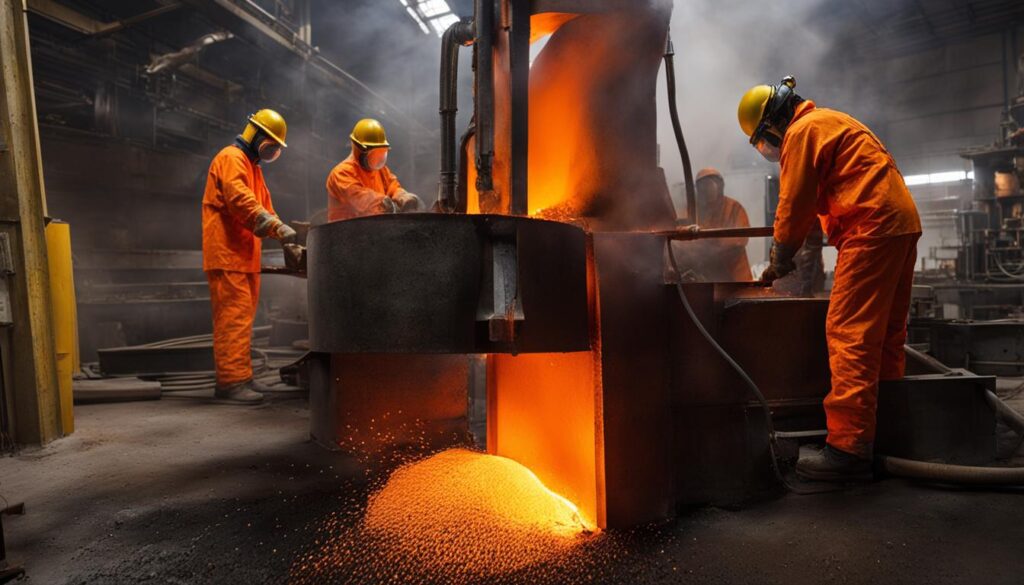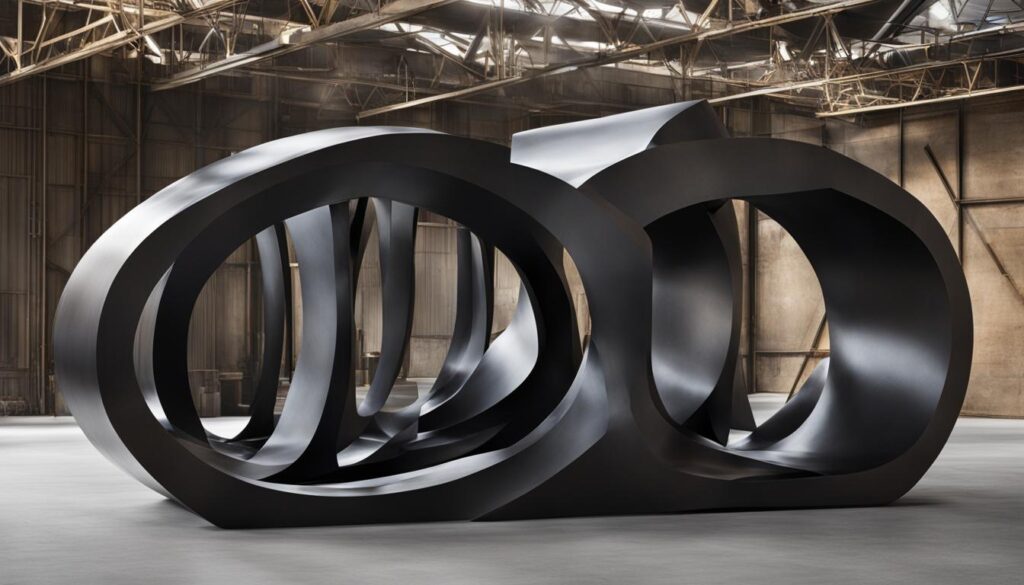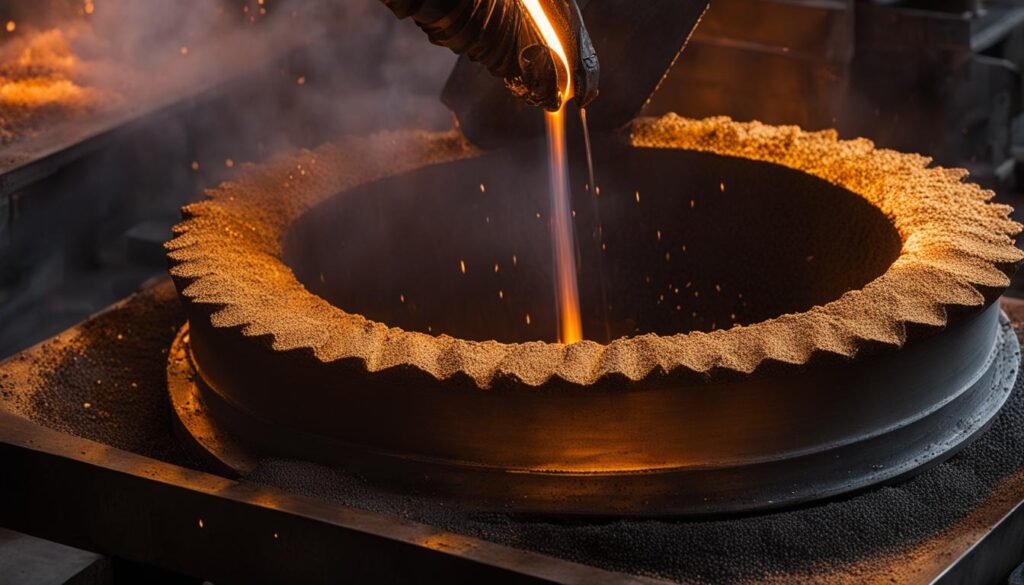Carbon steel casting is a fundamental process in manufacturing that involves the creation of metal components using carbon steel alloys. It is widely utilized in various industries due to its exceptional properties, including high pressure resistance, wear resistance, strength, and toughness. The composition of carbon steel, specifically the percentage of carbon, determines its mechanical properties and suitability for different applications.
At our company, KT-Foundry, we specialize in the investment casting of carbon steel alloys. With years of experience and expertise, we deliver high-quality carbon steel castings that meet the specific requirements of our clients. In this article, we will explore the basics of carbon steel casting, its benefits, and the grades and applications of carbon steel castings.
Key Takeaways:
- Carbon steel casting is widely used in various industries due to its exceptional properties.
- The mechanical properties of carbon steel are determined by the percentage of carbon present.
- KT-Foundry specializes in investment casting using carbon steel alloys.
- Carbon steel casting offers advantages such as high pressure resistance, wear resistance, strength, and toughness.
- Carbon steel castings have a wide range of applications in industries such as automotive, construction, and military equipment.
What is Carbon Steel?
Carbon steel is an iron-carbon alloy with varying carbon content, ranging from 0.0218% to 2.11%. It is a widely used material known for its strength and hardness. In addition to carbon, small amounts of other elements such as silicon, manganese, sulfur, and phosphorus may be present in carbon steel. The carbon content plays a crucial role in determining the properties of the steel, including its strength and hardness.
There are three main types of carbon steel based on carbon content: low carbon steel, medium carbon steel, and high carbon steel. Low carbon steel contains between 0.05% and 0.25% carbon, offering good ductility and strength. Medium carbon steel has a carbon content between 0.29% and 0.54% and is known for its wear resistance. High carbon steel, with a carbon content between 0.55% and 0.95%, possesses high tensile strength and shape memory.
Carbon steel is widely used in various industries due to its desirable properties. Its strength and hardness make it suitable for applications that require durability and resistance to wear. From automotive parts to construction materials, carbon steel plays a vital role in many sectors. The ability to customize carbon steel with different alloying elements further enhances its versatility and adaptability to specific requirements.

Key Points:
- Carbon steel is an iron-carbon alloy with varying carbon content.
- There are three main types of carbon steel: low carbon steel, medium carbon steel, and high carbon steel.
- Carbon steel is widely used in various industries due to its strength, hardness, and customization options.
Grades of Carbon Steel Casting
Carbon steel casting encompasses a range of grades based on the carbon content present. Each grade offers distinct properties and is suited for specific applications. The three main grades of carbon steel casting are low carbon steel, medium carbon steel, and high carbon steel.
Low Carbon Steel
Low carbon steel, also known as mild steel, contains a carbon content between 0.05% and 0.25%. It is known for its ductility and strength, making it suitable for applications that require good formability and weldability. Low carbon steel is commonly used in industries such as automotive manufacturing, construction, and general engineering.
Medium Carbon Steel
Medium carbon steel has a carbon content between 0.29% and 0.54%. It offers higher strength and wear resistance compared to low carbon steel. Medium carbon steel is commonly used in applications that require increased hardness and durability, such as gears, axles, and machinery parts. It is also used in the manufacturing of tools and equipment.
High Carbon Steel
High carbon steel has a carbon content between 0.55% and 0.95%. It possesses excellent tensile strength and shape memory, making it ideal for applications that require high strength and resistance to wear and tear. High carbon steel is commonly used in the production of springs, cutting tools, and components that withstand heavy loads and extreme conditions.
The different grades of carbon steel casting provide a range of options for various industries, offering the desired mechanical properties and performance required for specific applications. From low carbon steel’s formability to high carbon steel’s strength, each grade serves a purpose in delivering reliable and efficient solutions.
Carbon Steel Casting Process
Carbon steel casting can be produced using two different casting processes: Silica Sol Casting and Water Glass Casting. Both processes have their advantages and are suitable for different applications.
Silica Sol Casting
Silica Sol Casting, also known as lost wax casting, is a highly precise and intricate casting process. It offers better surface finish and tighter tolerances compared to Water Glass Casting. Silica Sol Casting is ideal for high-quality carbon steel castings that require intricate details and precise dimensions.
In this process, a wax pattern is created and coated with multiple layers of ceramic shell material. The wax is then melted out, leaving behind a hollow ceramic shell. Molten carbon steel is poured into the shell, filling the cavity. After solidification, the ceramic shell is broken away, revealing the carbon steel casting. The casting is then cleaned, heat-treated, and finished as per the desired specifications.
Water Glass Casting
Water Glass Casting, also known as sodium silicate casting, is a more cost-effective casting process compared to Silica Sol Casting. It is commonly used for carbon steel castings that do not require extreme precision or intricate details.
In this process, a mixture of water glass (sodium silicate) and other refractory materials is used to create the mold. The mixture is poured over the wax pattern, which is then coated with a fine sand mixture. The mold is allowed to cure, and then the wax is melted out, leaving behind a cavity. Molten carbon steel is poured into the cavity, filling the mold. After solidification, the mold is broken away, revealing the carbon steel casting. The casting is then cleaned, heat-treated, and finished as per the desired specifications.
| Casting Process | Advantages | Applications |
|---|---|---|
| Silica Sol Casting | High surface finish, tight tolerances | High-quality carbon steel castings with intricate details |
| Water Glass Casting | Cost-effective | Carbon steel castings that do not require extreme precision |
Both Silica Sol Casting and Water Glass Casting offer reliable and efficient methods for producing carbon steel castings. The choice of casting process depends on the specific application, budget, and desired level of precision. At KT-Foundry, we specialize in carbon steel castings using both processes, ensuring that we can meet our customers’ diverse needs with high-quality and cost-effective solutions.
Carbon Steel Casting Benefits
Carbon steel casting offers numerous benefits, making it a cost-effective and versatile choice for a wide range of applications. Its affordability compared to other materials, such as stainless steel, makes it an attractive option for businesses looking to reduce costs without compromising on quality. With its wide availability and customizable alloying options, carbon steel is highly adaptable to meet specific application requirements.
One of the key advantages of carbon steel casting is its high structural integrity. Carbon steel castings are known for their durability and reliability, making them suitable for demanding industries such as automotive, railway, and heavy equipment. The robust nature of carbon steel ensures that castings can withstand high pressures and wear, making them ideal for components subjected to harsh environments or heavy loads.
Carbon steel castings also offer a wide range of applications. From automotive parts to construction equipment, carbon steel can be utilized in various industries due to its versatility and strength. Its ability to be easily shaped and customized further enhances its appeal. Whether it’s for manufacturing machine components or structural supports, carbon steel castings provide the necessary functionality and performance.
Furthermore, carbon steel is highly recyclable, making it an environmentally friendly choice. As companies increasingly prioritize sustainability and environmental goals, carbon steel castings offer a sustainable solution. The ability to recycle and reuse carbon steel reduces waste and minimizes the need for new raw materials, contributing to a greener and more efficient manufacturing process.
| Benefits of Carbon Steel Casting |
|---|
| Cost-effective |
| Wide range of applications |
| Structural integrity |
| High durability and reliability |
| Customizable and versatile |
| Environmentally friendly and recyclable |
Carbon Steel Casting Grades and Applications

Carbon steel casting offers a wide range of grades to suit various applications in industries such as agriculture, automotive, petrochemical, and construction. Different grades of carbon steel have distinct mechanical properties, allowing for the selection of the most suitable grade based on specific requirements.
Grades of Carbon Steel Casting
When it comes to carbon steel casting, there are several commonly used grades. These include AISI 1010, AISI 1020, AISI 1035, AISI 1045, AISI 1060, and more. Each grade has its own unique composition, providing different levels of strength, hardness, and machinability. These attributes make them suitable for different applications and industries.
| Grade | Applications |
|---|---|
| AISI 1010 | Automotive parts, agricultural equipment |
| AISI 1020 | Construction components, industrial machinery |
| AISI 1035 | Heavy machinery, power transmission equipment |
| AISI 1045 | Hydraulic cylinder components, gears |
| AISI 1060 | Railway components, mining equipment |
These grades are chosen based on their specific properties, ensuring that the carbon steel castings meet the required performance standards for each application. The versatility of carbon steel casting grades makes them a reliable choice for a wide range of industries.
Applications of Carbon Steel Castings
Carbon steel castings find extensive use in various industries due to their cost-effectiveness, durability, and versatility. Some common applications include:
- Automotive parts: Carbon steel castings are used for components such as engine blocks, transmission parts, and suspension components.
- Agricultural equipment: Carbon steel castings are suitable for components like plowshares, tillage tools, and seed drills.
- Petrochemical industry: Carbon steel castings are used for valves, pumps, and other equipment that handle corrosive substances.
- Construction: Carbon steel castings are utilized in structural components, building hardware, and reinforcement bars.
These are just a few examples of the many applications where carbon steel castings prove invaluable. The ability to customize the grade of carbon steel used ensures that the castings meet the required specifications and performance standards of each specific application.
Manufacturing Carbon Steel Castings
The manufacturing process of carbon steel castings is a well-established and reliable choice for producing high-quality components. Carbon steel is a commonly used metal in various industries due to its cost-effectiveness and desirable mechanical properties. The process involves consistency and accuracy to ensure the production of reliable and precise castings.
At our company, we follow a meticulous manufacturing process for carbon steel castings. It starts with selecting the right ingredients, including the carbon steel alloy and any additional alloying elements needed to achieve the desired properties. The alloy composition is carefully controlled to ensure consistency and predictability.
Once the alloy is prepared, it is melted down and poured into molds to form the desired shape. The molds are designed to create the intricate details and complex geometries required by our customers. After solidification, the castings are carefully removed from the molds and undergo various finishing processes, including cleaning, heat treatment, and surface treatments.
Throughout the manufacturing process, our team of skilled engineers and technicians closely monitor each step to ensure the quality and integrity of the carbon steel castings. We conduct rigorous inspections and tests to verify the mechanical properties, dimensional accuracy, and surface finish of the castings.
Benefits of Carbon Steel Castings
Carbon steel castings offer numerous benefits, making them a cost-effective and versatile choice for various industries. With multiple material grades, recyclability, and high structural integrity, carbon steel castings provide exceptional value for businesses looking for reliable components.
One of the major advantages of carbon steel castings is their cost-effectiveness. Compared to stainless steel, carbon steel is more affordable, making it a preferred option for budget-conscious companies. The ability to customize carbon steel castings with different material grades further enhances their suitability for specific applications.
Another significant benefit is the recyclability of carbon steel castings. Being highly recyclable, carbon steel contributes to sustainable practices and environmental goals. This makes it an attractive choice for businesses that prioritize eco-friendly manufacturing processes.
The structural integrity of carbon steel castings is also worth noting. Carbon steel offers high strength and durability, ensuring the long-term performance and reliability of components. This makes carbon steel castings suitable for applications in industries such as automotive, railway, and heavy equipment.
| Benefits of Carbon Steel Castings |
|---|
| Cost-effective |
| Multiple material grades |
| Recyclability |
| Structural integrity |
Overall, carbon steel castings provide a cost-effective solution with multiple material grades, recyclability, and high structural integrity. Whether it’s for automotive, railway, heavy equipment, or other industries, carbon steel castings offer reliable and durable components without compromising on quality or environmental considerations.

The Best Carbon Steel Casting Manufacturer and Exporter
KT-Foundry is a reputable manufacturer and supplier of carbon steel investment castings in China. With our extensive experience in the industry, we offer a wide range of carbon steel castings in various alloys to cater to different customer requirements. Our manufacturing capabilities include stainless steel casting, alloy steel casting, carbon steel casting, and manganese steel casting.
At KT-Foundry, we understand the importance of delivering high-quality products that meet industry standards. We have a dedicated team of engineers and technicians who ensure that our carbon steel castings are precision-made with industry-leading tolerances. Our rigorous quality control processes ensure that each casting meets the desired mechanical properties, providing durability and reliability in various applications.

As a leading carbon steel casting manufacturer and supplier, we serve multiple industries such as agriculture, automotive, petrochemical, and construction. Our commitment to customer satisfaction has earned us a reputation for providing reliable and precise carbon steel castings. Whether you need components for your machinery, equipment, or structural applications, KT-Foundry is your trusted partner for high-quality carbon steel castings.
Steel Casting Services
At KT-Foundry, we offer a comprehensive range of steel casting services to meet diverse customer needs. Our expertise in carbon steel casting enables us to provide custom solutions tailored to specific project requirements. From design and engineering to prototyping and production, we deliver end-to-end steel casting services with unmatched quality and precision.
“Our commitment to customer satisfaction has earned us a reputation for providing reliable and precise carbon steel castings.”
| Why Choose KT-Foundry? | Benefits |
|---|---|
| Experience | We have decades of experience in the industry, ensuring high-quality and reliable carbon steel castings. |
| Customization | We offer customization options to meet specific project requirements, ensuring a perfect fit. |
| Quality Assurance | Our rigorous quality control processes ensure that each casting meets the desired mechanical properties and industry standards. |
| Industry Expertise | We cater to multiple industries, including agriculture, automotive, petrochemical, and construction, providing solutions for diverse applications. |
| Reliability | Our commitment to delivering reliable and precise castings has earned us the trust of our customers. |
Conclusion
In conclusion, carbon steel casting is of significant importance in various industries due to its cost-effectiveness, wide range of material grades, and recyclability. Understanding the basics of carbon steel casting is crucial for businesses seeking durable and reliable components. At KT-Foundry, we specialize in investment casting using carbon steel alloys, providing high-quality products that meet industry-leading tolerances and desirable mechanical properties.
They offer carbon steel castings in various alloys, catering to different customer requirements. With extensive experience and a range of manufacturing capabilities, Dawang Foundry serves multiple industries such as agriculture, automotive, petrochemical, and construction. Their commitment to providing reliable and precise carbon steel castings further establishes their position as a trusted industry leader.
Whether for automotive, railway, heavy equipment, or other industries, carbon steel castings from KT-Foundry offer a cost-effective solution without compromising on quality or integrity. The importance of carbon steel casting cannot be overstated, as it provides businesses with durable components that meet the demanding requirements of their respective applications.
FAQ
What is carbon steel casting?
Carbon steel casting is the process of creating objects or components using an alloy that contains carbon as the main alloying element. It is widely used in various industries for its strength, durability, and cost-effectiveness.
What are the different grades of carbon steel used in casting?
Carbon steel can be categorized into low carbon steel, medium carbon steel, and high carbon steel based on the carbon content. Each grade has different properties and is used for specific applications.
What are the main benefits of carbon steel casting?
Carbon steel casting offers cost-effectiveness, wide applications, high structural integrity, and recyclability. It is a popular choice for industries such as automotive, construction, and heavy equipment.
What is the process of carbon steel casting?
Carbon steel casting can be produced using two main processes: Silica Sol Casting (lost wax casting) and Water Glass Casting. These processes allow for the production of carbon steel castings with different tolerances and properties.
What are the differences between low carbon steel, medium carbon steel, and high carbon steel?
Low carbon steel has a lower carbon content and is known for its ductility and strength. Medium carbon steel offers good wear resistance, while high carbon steel has high tensile strength and shape memory.
What industries commonly use carbon steel castings?
Carbon steel castings are used in a wide range of industries, including automotive, railway, agriculture, petrochemical, and construction. They are versatile and can be customized to meet specific application requirements.
What are some commonly used grades of carbon steel in casting?
Some commonly used grades include AISI 1010, AISI 1020, AISI 1035, AISI 1045, and AISI 1060. These grades have different mechanical properties and are selected based on the desired strength, hardness, and machinability.


